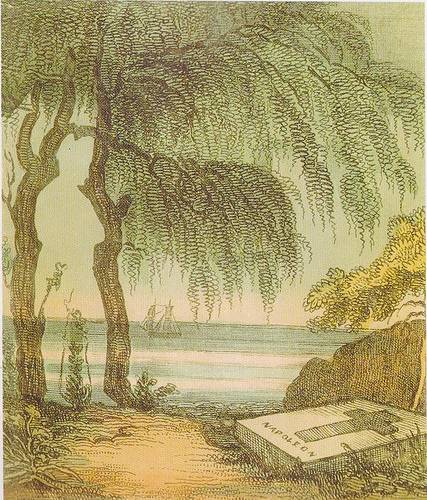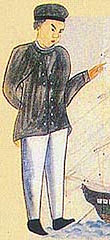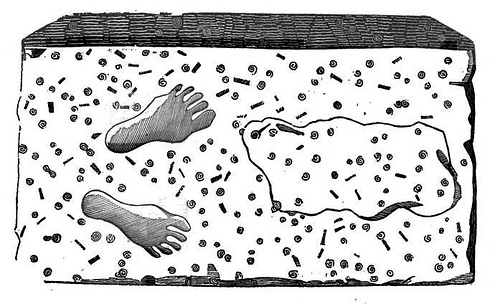
Oddities
A Grim Guest
Thomas Jolley Death has a brother named Sudden Death, as the former told when he was on a professional visit to Nottingham, Eng., as a private detective. The father of the two men may yet be alive, and if so, has probably had time to reflect upon the hideous names with which he labelled his two baby boys to go through the world. The real name of the family is D’Ath.
— Bizarre Notes & Queries, April 1886
Priming Effect
Add these numbers aloud:

When you’re certain of your answer, confirm it with a calculator.
Most people find they’ve made a mistake.
Long Way Home

Born in 1818, Yamamoto Otokichi was only 14 when a storm carried his transport ship away from his native Japan. The trip home took him literally around the world.
The ship drifted for more than a year across the Pacific while the crew drank desalinated water and slowly devoured the cargo of rice. By the time it reached the United States, all but three had died of scurvy, and the survivors were enslaved by Indians and then delivered to the Hudson’s Bay Company.
Their patron there sent them to London and then on to Macao in hopes they might help to open trade with the East. But Tokyo met their overtures with cannonfire, and Otokichi spent most of his remaining years as a seaman and translator.
He died in 1867 in Singapore, but his story has a belated resolution: In 2005, half of Otokichi’s remains were returned to his hometown in Japan — 187 years after he left.
Oops
In the Cathedral of Girgenti, in Sicily, the slightest whisper is borne with perfect distinctness from the great western door to the cornice behind the high altar, — a distance of two hundred and fifty feet. By a most unlucky coincidence, the precise focus of divergence at the former station was chosen for the place of the confessional. Secrets never intended for the public ear thus became known, to the dismay of the confessors, and the scandal of the people, by the resort of the curious to the opposite point, (which seems to have been discovered accidentally,) till at length, one listener having had his curiosity somewhat over-gratified by hearing his wife’s avowal of her own infidelity, this tell-tale peculiarity became generally known, and the confessional was removed.
— Charles Carroll Bombaugh, Gleanings for the Curious from the Harvest-Fields of Literature, 1890
Hope Springs Eternal

In central Bahrain stands a large mesquite known as the Tree of Life. It’s the only tree that survives in this part of the desert, and it’s been here for 400 years. No one knows where it’s finding water and nutrients.
See also Spectacularly Bad Driving.
Pyrexia
A Lusitanian physician had a patient who insisted upon it he was perpetually frozen, and would sit before a great fire even in the dog-days. The Portuguese Esculapius procured him a dress of rough sheep skins, saturated with aqua vita, and set him on fire. The patient then declared he was quite warm, rather too much so, and was cured.
— Cabinet of Curiosities, Natural, Artificial, and Historical, 1822
“Print of Human Feet in Rocks”

“Two apparent prints or impressions of the human foot in a tabular mass of limestone,” discussed in Schoolcraft’s Travels in the Central Portions of the Mississippi Valley, 1825:
The rock containing these interesting impressions is a compact limestone of a grayish blue color. It was originally quarried on the left bank of the Mississippi at St. Louis, and is a part of the extensive range of calcareous rocks upon which that town is built. Foundations of private dwellings, and the military works erected by the French and Spaniards, from this material, sixty years ago, are still as solid and unbroken as when first laid.
“The probability … of their having been imparted by some individual of a race of men who were unacquainted with the art of tanning skins, and at a period much anterior to that to which any tradition of the present race of Indians reaches, derives additional weight from this peculiar shape of the feet.”
So There
When the Russian prince Dimitri, the son of Ivan II, was assassinated on May 15, 1591, at Uglich, his place of exile, the great bell of that town rang the signal of insurrection. For this serious political offence the bell was sentenced to perpetual banishment in Siberia, and conveyed with other exiles to Tobolsk. After a long period of solitary confinement it was partially purged of its iniquity by conjuration and re-consecration and suspended in the tower of a church in the Siberian capital; but not until 1892 was it fully pardoned and restored to its original place in Uglich. A like sentence was imposed by a Russian tribunal on a butting ram in the latter half of the seventeenth century.
— E.P. Evans, The Criminal Prosecution and Capital Punishment of Animals, 1906
Eternal Flame Falls

Under a waterfall in New York’s Chestnut Ridge Regional Park there’s a grotto that emits natural gas.
It can be lit to produce a flame.
